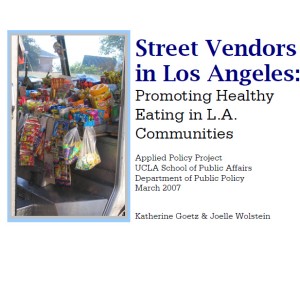
Authors: Katherine Goetz, Joelle Wolstein
Date: March 1, 2007
Project: [wpv-post-link id=”$project”]
Throughout Los Angeles, but particularly in low-income areas, street vendors sell enticing high-sugar, high-fat foods outside elementary schools. In light of the alarming increase in childhood obesity, vendor activity has gotten the attention of schools and many community based obesity-prevention organizations. Of concern to the schools and the Los Angeles Unified School District (LAUSD) is the way street vendors undermine newly implemented nutrition policies. These policies promote healthier eating within the schools by improving the nutritional content of foods served and sold on school grounds. Although LAUSD’s efforts have contributed to healthier lunches and have eliminated the sale of junk foods on campuses, students are still consuming unhealthy snacks immediately after the school day ends. Obesity-prevention groups believe the street vendors may be contributing to the prevalence of obesity.
The childhood obesity epidemic in the U.S. affects over nine million children and youth over the age of six. Recent figures show that 17.1% of children are obese and another 16.5% are at risk of becoming obese. Estimates predict that if nothing is done to reverse this trend, 20% of children in the U.S. will be obese by 2010.
In particular, the prevalence of obesity is higher in minorities and low-income individuals. In Los Angeles, 28.2% of people living below the Federal Poverty Line (FPL) are obese, while only 16.5% of those living at or above 300% of the FPL are obese. Data from the 2005 L.A. County Health Survey show that the rate of obesity is significantly higher in African Americans and Latinos than in Asians or Whites. Because most of the street vendors work in predominantly low-income and Latino areas, the students buying these snacks are already at higher risk of becoming obese.
To determine the nutritional impact of snacks sold by vendors, we surveyed students in three elementary schools in South Central Los Angeles and found that 83% of students buy snacks from the street vendors, and 44% do so at least three or four times a week. We estimated the average calories in these snacks and determined that students who buy these snacks devote a large percentage of their daily caloric intake to unhealthy foods like chips and soda. Furthermore, this consumption of unhealthy snacks leads students to surpass their daily recommended caloric intake, which will result in weight gain unless balanced by physical activity. Given the low level of organized physical activity in these schools, in addition to other environmental barriers to physical activity in low-income neighborhoods, the students are unlikely to be exercising enough to balance this surplus consumption.
Based on our findings regarding the frequency of snack purchases by students and the impact on their daily nutritional intake, our client, the Healthy Eating, Active Communities Initiative (HEAC) should take steps to limit the vendors’ influence on these environments. The status quo is not acceptable because enforcement of anti-vending laws is insufficient and there are not enough resources to expand enforcement. Without an intervention, the supply and demand for these goods will persist. Based on theories about behavior change and previous nutrition interventions to reduce unhealthy snacking, we provide the following recommendations for HEAC:
1. Work with the schools to create a program of healthy after-school snack sales to provide a healthy alternative for the students who want snacks after school.
2. Work with the schools to increase nutrition education and information about the negative impact of unhealthy snacks on one’s health.
3. Use informal outreach to work with the vendors so that they will sell healthier options.
Link to Publication